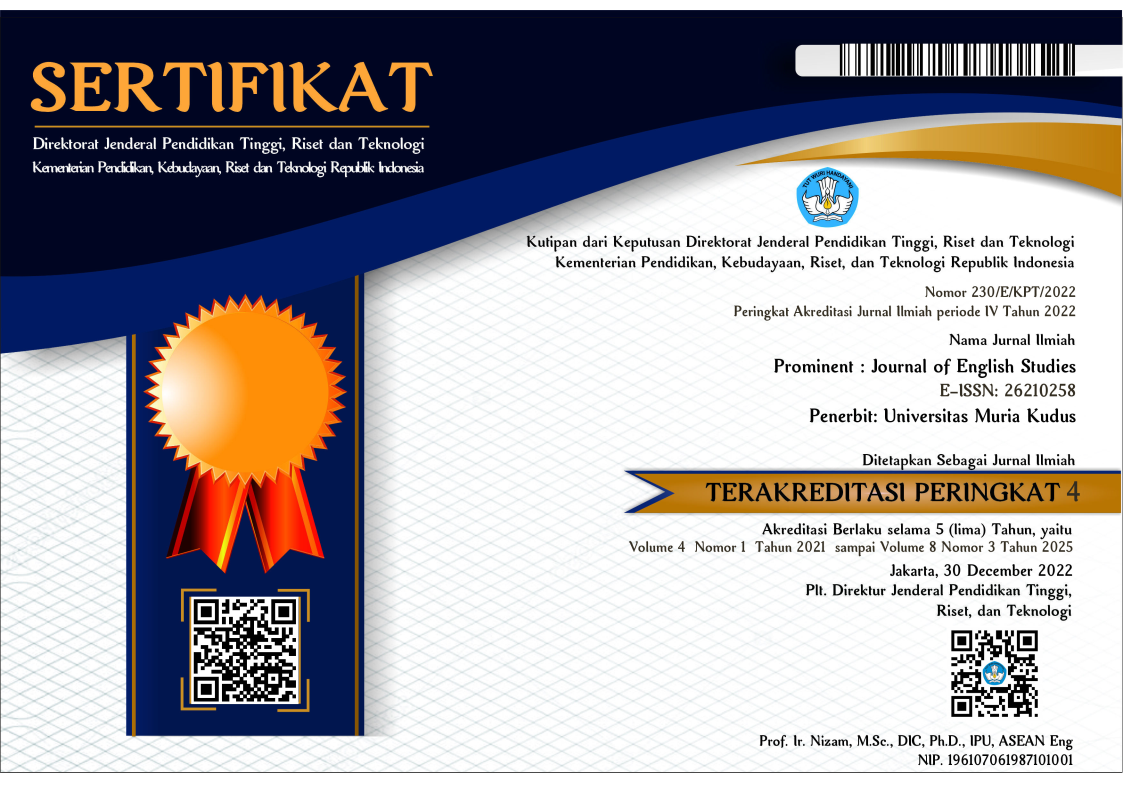USING SHORT STORY GAP FILL TO ENHANCE STUDENTS’ LISTENING COMPREHENSION ABILITY
Abstract
This research explained how listening comprehension by Short Story Gap Fill improved students’ listening comprehension achievement, observed students’ behavior during listening comprehension class and described the teacher’s Gap Fill technique along with the research. It used Classroom Action Research (CAR) with quantitatively data then analyzed into qualitative. The qualitative data were about students’ interview, while the quantitative data was their scores in pre-test and post-test on listening comprehension. Short Story Gap Fill contained listening comprehension exercises which tend to prove the missing words or phrases on a script of a story or a dialog; they were “pre, while and post-listening which focused on students’ ability to carry out the gap on the listening exercises. This research consisted of two cycles. The findings involved, the third-semester students of the English Department were fascinated by Short Story Gap Fill and immersed in listening comprehension well. However, during the first cycle, there were still 3 from 31 incompletely fulfill the gap in listening comprehension because they could not catch the vocabulary well and less focus. Ultimately, on the second cycle, the students' accomplishment in listening comprehension through this technique improved dramatically on their score of using the same technique.
Keywords: CAR, Gap Fill, Listening Comprehension
Full Text:
PDFReferences
Brown, S. (2006). Teaching Listening. Cambridge: Cambridge University Press.
Cikal (2018). Semarang, Central Java. Retrieved December 16, 2018
Daffa (2018). Daffa, F. Recorded in December 2nd.
Darti and Asmawati. (2017, December). Analyzing Students’ Difficulties Toward Listening Comprehension. National Journal, 3(2).
Dick, B. (2004). Action Research Literature Themes and Trends,. Action Research, 2(4), 425-444.
Dick, B. (2006). Action Research Literature. Action Research, 4(4), 439-458.
Hadijah and Salawati . (2016). A Study on Listening Skills and Perspective to First Year Students at English Department of Academic Year 2015/2016. Retrieved from https://www.researchgate.net/publication/ 316277855
Hamouda, A. (2003). An Investigation of listening Comprehension Problems Encountered by Saudi Students in the EL Listening Classroom. HR Mars: International Journal of Academic Research in Progressive and Development.
Harmer, J. (1983). The Practice of English Language Teaching. London: Longman.
Ikhsanudin, M. W. (2015, May 11). Pendidikan . Retrieved from abibulah.blogspot.co.id: http://abibulah.blogspot.co.id/2015/05/metode-penelitian-tindakan-kelas.html
Intansari, H. (2017). Rencana Pembelajaran Semester (RPS) Listening Comprehension. (Revisi.1 ed., Vol. Semester 3). Semarang: PBI UNISSULA.
Kauffman. (2016, October 2). Why is listening important in language learning? Retrieved from https://englishin10minutes.com/2016/10/02/why-is-listening-important-in-language-learning/
Kemmis, S., and McTaggart, R . (1988). The Action Research Planner (3 ed.). Victoria: Australia: Deakin University Press.
Mertler, C. A. (2017). Action research: Improving schools and empowering educators. (5, Ed.) CA. SAGE.
Underwood, M. (1990). Longman Handbooks for Language Teachers. In Teaching Listening (pp. 16-19). London: Longman.
Vandergrift, L. (2009, October). Listening Theory and Practice in Modern Foreign Language Competence. Retrieved from https://www.llas.ac.uk/resources/gpg/67
Winter, R. a.-G. (2001). A Handbook for Action Research in Health and Social Care. Routledge: London and New York.
DOI: https://doi.org/10.24176/pro.v2i2.4150
Refbacks
- There are currently no refbacks.
Prominent Journal of English Studies is licensed under a Creative Commons Attribution-ShareAlike 4.0 International License.
Dedicated to:

in Collaboration with APSPBI:






